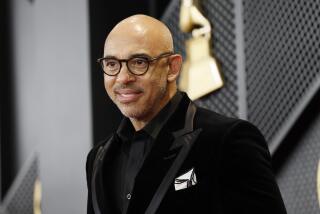THE 35TH ANNUAL GRAMMY AWARDS : Clapton Gets His Due, New Bloods Too : THE ARRIVALS : The Required Garb: ‘Rock ‘n’ Roll Formal’
The Grammy arrivals are really a fashion show with attitude.
Perhaps this is the one area where the music awards beat out the Oscars. Unlike musicians, actors seem to have little need to express personal disdain toward traditional formal attire.
As an example, D’Mitch Davis, who occasionally sings the national anthem for the Clippers, came as a “seat filler.” This means he jumps in and out of seats when nominees are backstage. This keeps the audience from appearing half-empty when television cameras pan.
At the Oscars, seat fillers dress more anonymously than a cheap restaurant’s maitre d’. At the Grammys, Davis was anything but low-key. He was resplendent in an Italian silk tux done in black and gray stripes, white silk scarf, brown leather cowboy hat and snakeskin boots. “Python,” he pointed out. “The ones with the big teeth and the big skin.”
It’s a tribute to the eccentricity of the Grammy crowd that Davis fit right in. “Rock ‘n’ roll formal” is the way Irving Azoff, chairman of the Grammy host committee, described the dress attire. “The old guys are in tuxedos, the young ones go in for some interesting twists.”
Unfortunately, this twisting parade of erratic fashion is kept away from the public eye. Unlike the Oscars, where bleachers filled with fans greet star arrivees, for the most part the artist arrivals for the Grammys are a more hidden affair. The front door is primarily used by the audience--no slouches at fashion themselves, but not in the same league as the artists.
The Talent, as everyone from classical conductors to heavy metal bass players are referred to, don’t come in the front door as they do for the Oscars. They are brought to the Shrine Auditorium’s rear parking area. On Grammy night, this looks like a minimum-security prison that’s hosting a very weird prom. A black metal gate opens and closes, security guards too numerous to count prowl the perimeter and a seemingly endless parade of limos disgorge the Talent.
Though there is only a quick glimpse of the artists as they arrive, some general principles seem to repeat.
Talent, especially Talent with a rebellious edge, under no circumstance wear a typical tuxedo. The idea is that the Talent mocks the false values implicit in formal wear. Even Tony Bennett, who wouldn’t seem to have much to rebel about, wore a white tux jacket.
Though Talent should avoid tuxedos, it can wear tux parts and still be hip. The most obvious is to go for the ever popular tux-with-a-T-shirt look. Or a tux jacket with blue jeans. One standout was Louie Weaver of Petra, who wore an orange jacket embroidered with a car design, blue jeans, cowboy boots with looped chains, a black shirt and a tuxedo-style black bow-tie. If there was an award for best use of the most minor tux part it would go to Weaver.
Country Talent have much more scope for both being both country and formal. At a conservative end it might be cowboy boots and a bolo tie, at the other end a black cowboy hat and black leather jacket with a vaguely Navajo design on the back. Singers Marty Stuart and Travis Tritt looked like bookends with Stuart in white leather and Travis in black. Worst taste in shoes went to the guy wearing black boots with an inlay of pony fur: Like any real cowboy could do that to his horse.
A perennial of years past, white tennis shoes with tuxedo, was almost altogether missing. Obviously, this is a bad year to evoke Woody Allen’s style.
For women, the long-established music industry rule that no dress is too short, too tight or too revealing is still in effect. One writer described the look as “elegantly cheesy.”
As far as the music industry is concerned, cleavage is still in. Perhaps it’s not as blatant as in years past, but the lyrics “Ain’t no mountain high enough, ain’t no valley low enough” applied to many of the gowns.
Actress Annie McAuley arrived in tight black leather hot pants, a Moschino tux jacket with tails stretching to the ground and a push-up, beaded bustier. “For the Grammys, I pull out all the stops,” McAuley said. “It’s the one time I can wear all my outrageous clothes in L.A.” Her boyfriend described her look as “dressed to compress.”
Singer Alannah Myles came in a black leather biker jacket, matching pants with long fringe and cowboy boots with spurs. “This is the way I dress,” she said. “I’m a woman in rock and these are my work clothes.”
Though Myles was a nominee, this year she arrived with the audience by the front entrance where protesters tried to attract attention from across the street.
The largest of the groups included 75 teen-agers protesting the alleged lack of Mexican artists nominated for Grammys. “The nominees for Mexican music are people you never hear on Spanish radio,” Sergio Gonzalez said. “The people we hear and whose records we buy are never nominated.”
A smaller group comprised a half-dozen feminists who were handing out flyers in front of a 20-foot-high by 15-foot-wide inflatable balloon of a woman’s derriere. They were protesting sexual harassment in the record industry.
The balloon had been set up to promote Sir Mix-A-Lot’s “Baby’s Got Back.” The feminists used the locale to reinforce their point.
More to Read
The biggest entertainment stories
Get our big stories about Hollywood, film, television, music, arts, culture and more right in your inbox as soon as they publish.
You may occasionally receive promotional content from the Los Angeles Times.










